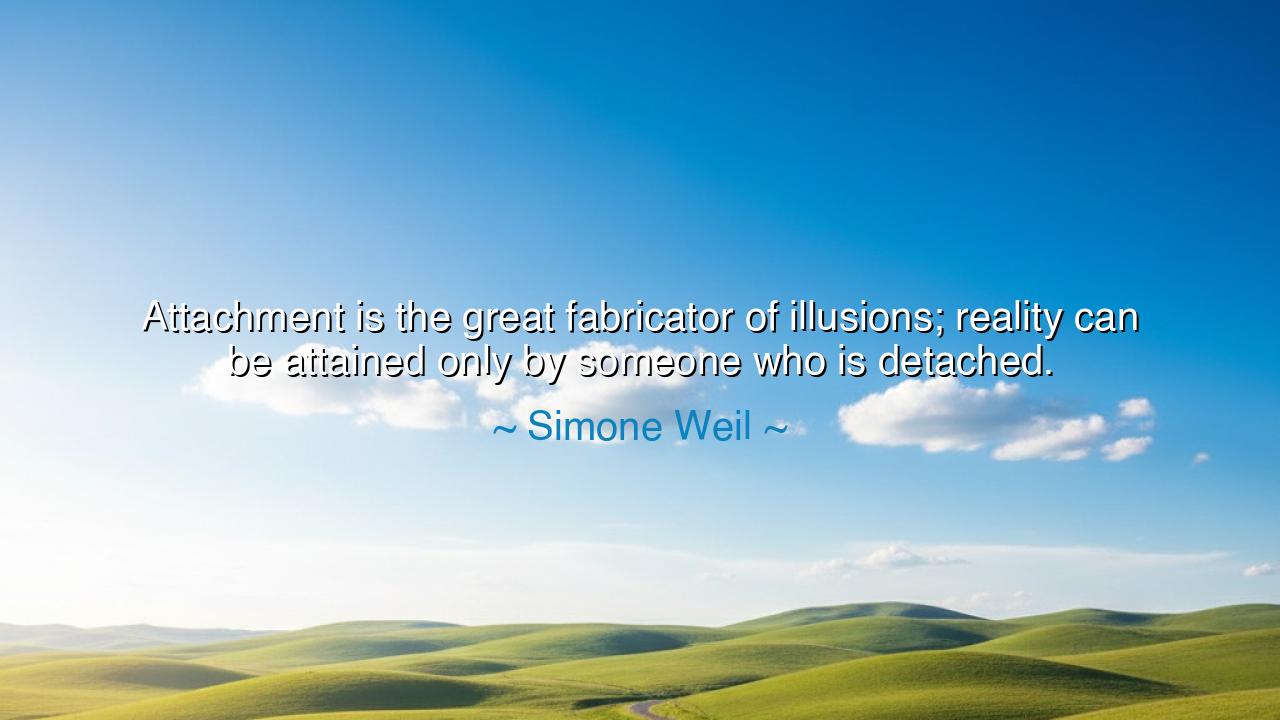
Attachment is the great fabricator of illusions; reality can be
Attachment is the great fabricator of illusions; reality can be attained only by someone who is detached.






“Attachment is the great fabricator of illusions; reality can be attained only by someone who is detached.” Thus wrote Simone Weil, the philosopher of compassion and solitude, a woman who sought truth not in the comfort of ideas but in the crucible of experience. Her words are not gentle; they are a blade meant to sever illusion from truth, desire from clarity. In this saying, she reveals one of the oldest and most challenging truths of existence—that what binds us most tightly to suffering is not the world itself, but our attachment to it: to our desires, our fears, our possessions, even our own image of self.
To understand her meaning, we must first grasp what she calls the fabricator of illusions. Attachment is the weaver of falsehoods; it makes us believe that happiness depends upon what can be lost. It binds our hearts to the temporary and convinces us that impermanent things are eternal. When we cling to wealth, beauty, love, or recognition, we begin to live inside a dream of control—a fragile dream that shatters the moment reality changes. And change it always does. Simone Weil teaches that this clinging blinds us to the deeper harmony of existence. We see not the world as it is, but as we wish it to be. Thus, we live half-awake, lulled by the soft illusions of desire.
This truth was known even to the ancients. The Buddha, sitting beneath the Bodhi tree, came to the same realization: that suffering arises from attachment, and liberation from suffering begins when one releases the grasping of the mind. He saw how people chase pleasure and flee pain, forever enslaved by what they crave and what they fear. When the grasp relaxes, when one learns to watch the world without trying to hold it, then reality reveals itself—not as a possession, but as a presence. Detachment is not coldness; it is clarity. It is the calm of a lake that reflects the sky perfectly because it does not stir.
Simone Weil’s own life was a living embodiment of this truth. Born into comfort, she chose the path of sacrifice and simplicity, working in factories and on farms so she might experience the suffering of others. She stripped herself of privilege, refusing even to eat more than what was allotted to soldiers in war. To her, detachment was not a philosophy but a spiritual discipline, a way to peel away the illusions that shield the heart from compassion. By freeing herself from the hunger of ego, she could see the reality of human suffering without distortion—and love purely, without condition or reward. Her detachment was not indifference but devotion.
The heart of her teaching is paradoxical: to attain reality, one must let go of all that seems most real. Our attachments—to identity, to success, to love—feel like the pillars of our being, but they are only shadows cast upon the wall of the mind. True reality lies beyond them, vast and quiet, unshaken by loss or gain. This is what the sages of every age have sought: not the extinction of emotion, but its purification. When one is detached, love itself becomes more profound, for it is no longer born of need or fear. It becomes a light that seeks nothing, not even its own reflection.
We see this same truth in the life of Marcus Aurelius, the Roman emperor who ruled with wisdom amidst the storms of empire. Surrounded by power, he practiced detachment as a way to stay free. In his Meditations, he wrote: “Receive without pride, let go without attachment.” He knew that all crowns turn to dust, all applause fades into silence. Yet in this impermanence, he found peace. He learned, as Weil did, that to cling is to suffer, but to accept is to be serene.
The lesson, then, is not to reject the world, but to love it without chains. To walk among beauty and joy, but not become their prisoner. To act fully, yet without the fever of desire for reward. This is the art of detachment—a stillness of soul that sees clearly, loves deeply, and suffers less because it no longer confuses possession with connection. To be detached is to be free, not from life, but within it—to see things as they are, not as the mind demands they should be.
So, my child, when you find yourself clutching at what cannot be kept—at praise, at wealth, at love—remember Simone Weil’s words. Loosen your grasp, and see what remains. What is real cannot be lost. What is eternal asks for no attachment. Learn to live with open hands: to give freely, to receive with gratitude, and to let go when the moment passes. For in the end, the one who is detached is not without love, but full of it—because they have ceased to cling to illusion and now embrace the whole of reality.






AAdministratorAdministrator
Welcome, honored guests. Please leave a comment, we will respond soon